Spatiotemporal Variation Characteristics of Reference Evapotranspiration and Relative Moisture Index in Heilongjiang Investigated through Remote Sensing Tools
Abstract
:1. Introduction
2. Materials and Methods
2.1. Study Area
2.2. Data Source
2.2.1. MOD16 Products
2.2.2. Meteorological Data
2.3. Calculation of Reference Evapotranspiration (ET0) and Relative Moisture Index (MI)
2.3.1. Reference Evapotranspiration (ET0)
2.3.2. Relative Moisture Index (MI)
2.4. Validations of the MOD16 Data
2.5. Research Methods
2.5.1. Climate Tendency Rate
2.5.2. Morlet Wavelet Analysis
2.5.3. Partial Correlation Analysis
3. Results
3.1. Spatiotemporal Distribution of ET and PET
3.2. Interannual Variation in ET0, Precipitation and MI
3.3. Monthly Variation in ET0, Precipitation and MI
3.4. Periodic Characteristics of ET0 and MI
3.4.1. Periodic Characteristics of ET0
3.4.2. Periodic Characteristics of MI
3.5. Influencing Factors of ET0 and Their Trend Characteristic
4. Discussion
4.1. Applicability of the MOD16 Products in Humid and Semi-Humid Areas
4.2. Cause Analysis of the Variation Trend of the Influencing Factors of ET0
5. Conclusions
- (1)
- After removing outliers from ET and PET in Heilongjiang from 2000 to 2017, it was found that the volatility and stability were similar, and the correlation coefficient (R2) reached 0.4621**, indicating a significantly increasing trend. The spatial distribution of ET and PET in the humid, normal and arid years varied greatly among different regions in Heilongjiang, showing a general distribution pattern of being higher in the southwest and lower in the northwest, and higher in the south and lower in the north. Compared with ET in Heilongjiang in the humid, normal and arid years, high value centers and low value centers in PET in Heilongjiang were less common than those in ET. Except for two drought years, 2000 and 2001, PET was greater than ET in Heilongjiang from 2002 to 2017, and the difference between the two was small, indicating that the overall moisture in Heilongjiang was sufficient in these years.
- (2)
- From 1980 to 2019, the average annual precipitation in the study area decreased significantly at a rate of 3.707 mm/a, the average annual ET0 increased at a rate of 0.002 mm/a and the average annual MI decreased at a rate of 0.005/a. At the annual scale, Heilongjiang and its six ecological regions were drought free. At the monthly scale, monthly ET0 and monthly precipitation in Heilongjiang increased first and then decreased, while monthly MI showed the opposite trend to monthly ET0 and monthly precipitation. Heilongjiang was generally wet, but there was drought in some parts in some months. The EA district experienced light drought in May, the CM district experienced light drought in June and July, and the GKM experienced it in February and May, as well as moderate drought in March and April. The first primary period of annual ET0 was 28 a and the second primary period was 6 a. The interannual MI had three main periodicities: 5, 8 and 17 a. This research filled the research gap of studies on ET0 at a monthly scale in various ecological regions of Heilongjiang Province.
- (3)
- The main factors affecting ET0 in Heilongjiang Province from 1980 to 2019 were average wind speed, sunshine duration and average relative humidity. On a 40-year scale, the average temperature, daily maximum temperature and daily minimum temperature in Heilongjiang all exhibited a positive trend to varying degrees, while the average relative humidity, average wind speed and sunshine duration had a decreasing trend. Since the sunshine duration and average wind speed in Heilongjiang Province exhibited few changes, while the average relative humidity exhibited a large change rate, it was believed that the increase in ET0 in Heilongjiang Province during 1980–2019 was mainly caused by the variation in average relative humidity.
Author Contributions
Funding
Data Availability Statement
Conflicts of Interest
References
- Wang, D.; Wang, D.; Mo, C. The Use of Remote Sensing-Based ET Estimates to Improve Global Hydrological Simulations in the Community Land Model Version 5.0. Remote Sens. 2021, 13, 4460. [Google Scholar] [CrossRef]
- Milly, P.C.D.; Dunne, K.A. Potential evapotranspiration and continental drying. Nat. Clim. Chang. 2016, 6, 946–949. [Google Scholar] [CrossRef]
- Mu, L.; Lu, Y.X.; Liu, M.G.; Yang, H.M.; Feng, Q.S. Characterizing the spatiotemporal variations of evapotranspiration and aridity index in mid-western China from 2001 to 2016. J. Arid Land. 2021, 13, 1230–1243. [Google Scholar] [CrossRef]
- Tian, S.Q.; Wang, S.J.; Bai, X.Y.; Luo, G.J.; Li, Q.; Yang, Y.J.; Hu, Z.Y.; Li, C.J.; Deng, Y.H. Global patterns and changes of carbon emissions from land use during 1992–2015. Environ. Sci. Ecotechnol. 2021, 7, 100108. [Google Scholar] [CrossRef] [PubMed]
- Dinpashoh, Y.; Jhajharia, D.; Fakheri-Fard, A.; Singh, V.P.; Kahya, E. Trends in reference crop evapotranspiration over Iran. J. Hydrol. 2011, 399, 422–433. [Google Scholar] [CrossRef]
- Vicente-Serrano, S.M.; Azorin-Molina, C.; Sanchez-Lorenzo, A.; Revuelto, J.; Morán-Tejeda, E.; López-Moreno, J.I.; Espejo, F. Sensitivity of reference evapotranspiration to changes in meteorological parameters in Spain (1961–2011). Water Resour. Res. 2014, 50, 8458–8480. [Google Scholar] [CrossRef]
- Patle, G.T.; Sengdo, D.; Tapak, M. Trends in major climatic parameters and sensitivity of evapotranspiration to climatic parameters in the eastern Himalayan region of Sikkim, India. J. Water Clim. Chang. 2020, 11, 491–502. [Google Scholar] [CrossRef]
- Gan, T.W. Hydroclimatic trends and possible climatic warming in the Canadian prairies. Water Resour. Res. 1998, 34, 3009–3015. [Google Scholar] [CrossRef]
- Xu, C.Y.; Gong, L.B.; Jiang, T.; Chen, D.L.; Singh, V.P. Analysis of spatial distribution and temporal trend of reference evapotranspiration and pan evaporation in Changjiang (Yangtze River) catchment. J. Hydrol. 2006, 327, 81–93. [Google Scholar] [CrossRef]
- Zhang, Q.; Yu, X.; Qiu, R.J.; Liu, Z.X.; Yang, Z.Q. Evolution, severity, and spatial extent of compound drought and heat events in north China based on copula model. Agric. Water Manag. 2022, 273, 107918. [Google Scholar] [CrossRef]
- Lu, H.J.; Mo, X.G.; Meng, D.J.; Liu, S.X. Analyzing spatiotemporal patterns of meteorological drought and its responses to climate change across Northeast China. Scientia Geographica Sinica 2015, 35, 1051–1059. [Google Scholar] [CrossRef]
- Zhao, Z.Y.; Wang, H.R.; Yu, C.; Deng, C.N.; Liu, C.L.; Wu, Y.F.; Yan, J.W.; Wang, C. Changes in spatiotemporal drought characteristics over northeast China from 1960 to 2018 based on the modified nested Copula model. Sci. Total Environ. 2020, 739, 140328. [Google Scholar] [CrossRef] [PubMed]
- Li, X.F.; Zhu, H.X.; Li, X.F.; Wang, P.; Jiang, L.X.; Zhao, H.Y. Spatial and temporal patterns of dry and wet climate in Heilongjiang Province from 1961 to 2018. J. Northeast. For. Univ. 2019, 47, 73–78,99. [Google Scholar] [CrossRef]
- Yan, Y.Q.; Shen, S.G.; Yue, Y.; Wang, Q.; Liu, H.Q. Characteristics and dominant factors of dry and wet evolution in Heilongjiang Province from 1980 to 2014 under multi-time scales. J. Meteorol. Sci. 2018, 20, 200–208. [Google Scholar] [CrossRef]
- Dias, S.H.B.; Filgueiras, R.; Fernandes, F.E.I.; Arcanjo, G.S.; Silva, G.H.d.; Mantovani, E.C.; Cunha, F.F.d. Reference evapotranspiration of brazil modeled with machine learning techniques and remote sensing. PLoS ONE 2021, 16, e0245834. [Google Scholar] [CrossRef] [PubMed]
- Castelli, M. Evapotranspiration Changes over the European Alps: Consistency of Trends and Their Drivers between the MOD16 and SSEBop Algorithms. Remote Sens. 2021, 13, 4316. [Google Scholar] [CrossRef]
- Song, J.; Xu, C.C.; Yang, Y.Y.; Zhang, X.C.; Li, X.F. Spatio-temporal variation of dry and wet climate in Xinjiang Based on MODIS16 and its influencing factors. Res. Soil. Water Conserv. 2019, 26, 210–214+221+2. [Google Scholar] [CrossRef]
- Mu, Q.; Zhao, M.; Running, S.W. Improvements to a MODIS global terrestrial evapotranspiration algorithm. Remote Sens. Environ. 2011, 115, 1781–1800. [Google Scholar] [CrossRef]
- Cheng, M.H.; Jiao, X.Y.; Jin, X.L.; Li, B.B.; Liu, K.H.; Shi, L. Satellite time series data reveal interannual and seasonal spatiotemporal evapotranspiration patterns in China in response to effect factors. Agric. Water Manag. 2021, 255, 107046. [Google Scholar] [CrossRef]
- Chang, Y.P.; Qin, D.H.; Ding, Y.J.; Zhao, Q.D.; Zhang, S.Q. A modified MOD16 algorithm to estimate evapotranspiration over alpine meadow on the Tibetan Plateau, China. J. Hydrol. 2018, 561, 16–30. [Google Scholar] [CrossRef]
- Running, S.W.; Mu, Q.; Zhao, M.; Moreno, A. User’s Guide MODIS Global Terrestrial Evapotranspiration (ET) Product (NASA MOD16A2/A3) NASA Earth Observing System MODIS Land Algorithm. 2016. Available online: https://landweb.modaps.eosdis.nasa.gov/QA_WWW/forPage/user_guide/MOD16UsersGuide2016.pdf (accessed on 31 August 2016).
- Zhang, H.; Zhang, L.; Zhang, Q.; Liu, Q.; You, X.; Wang, L. Analysis of the Difference between Climate Aridity Index and Meteorological Drought Index in the Summer Monsoon Transition Zone. Remote Sens. 2023, 15, 1175. [Google Scholar] [CrossRef]
- Huang, T.; Wu, Z.; Xiao, P.; Sun, Z.; Liu, Y.; Wang, J.; Wang, Z. Possible Future Climate Change Impacts on the Meteorological and Hydrological Drought Characteristics in the Jinghe River Basin, China. Remote Sens. 2023, 15, 1297. [Google Scholar] [CrossRef]
- Du, E.; Chen, F.; Jia, H.; Wang, L.; Yang, A. Spatiotemporal Evolution and Hysteresis Analysis of Drought Based on Rainfed-Irrigated Arable Land. Remote Sens. 2023, 15, 1689. [Google Scholar] [CrossRef]
- Tsakiris, G.; Pangalou, D.; Vangelis, H. Regional Drought Assessment Based on the Reconnaissance Drought Index (RDI). Water Resour. Manag. 2007, 21, 821–833. [Google Scholar] [CrossRef]
- Feng, J.S.; Wang, J.Y.; Wang, X.T.; Xue, X.P.; Chen, Y.C.; Li, H.Y.; Fan, L.J. The Application of Relative Humidity Index to Agricultural Drought Monitoring. J. Appl. Meteorol. Sci. 2011, 22, 766–772. [Google Scholar] [CrossRef]
- Wu, B. Study on adaptability of relative humidity index in Jianghuai River Basin. Earth 2015, 8, 389–390. [Google Scholar]
- Dhillon, M.S.; Dahms, T.; Kübert-Flock, C.; Liepa, A.; Rummler, T.; Arnault, J.; Steffan-Dewenter, I.; Ullmann, T. Impact of STARFM on Crop Yield Predictions: Fusing MODIS with Landsat 5, 7, and 8 NDVIs in Bavaria Germany. Remote Sens. 2023, 15, 1651. [Google Scholar] [CrossRef]
- Zhou, L.; Cheng, L.; Qin, S.; Mai, Y.; Lu, M. Estimation of Urban Evapotranspiration at High Spatiotemporal Resolution and Considering Flux Footprints. Remote Sens. 2023, 15, 1327. [Google Scholar] [CrossRef]
- Liu, Z.H.; Jing, D.; Han, Y.; Yu, J.X.; Lu, T.G.; Zhangzhong, L.L. Spatiotemporal Distribution Characteristics and Influencing Factors Analysis of Reference Evapotranspiration in Beijing–Tianjin–Hebei Region from 1990 to 2019 under Climate Change. Sustainability 2022, 14, 6277. [Google Scholar] [CrossRef]
- Thomas, E.; Joseph, I.; Abraham, N.P. Wavelet analysis of annual rainfall over Kerala and sunspot number. New. Astron. 2023, 98, 101944. [Google Scholar] [CrossRef]
- Fuente, A.D.L.; Bing, N.; Hoeschele, I.; Mendes, P. Mendes, Discovery of meaningful associations in genomic data using partial correlation coefficients. Bioinformatics 2004, 20, 3565–3574. [Google Scholar] [CrossRef] [PubMed]
- Wang, Z.L.; Liu, Y.; Jiang, Q.X.; Li, S.Q.; Chai, X.; He, X. Analysis on change of reference crop evapotranspiration and meteorological factors in Heilongjiang Province. J. Water Resour. Water Transp. Eng. 2021, 2, 46–56. [Google Scholar] [CrossRef]
- He, B. Sensitivity factor analysis of ET in Jizhou district of Tianjin based on MOD16 data. Surv. Mapp. Spat. Geogr. Inf. 2022, 45, 103–105. [Google Scholar]
- Andrade, N.L.R.; Sandwiches, L.; Zeilhofer, P.; João, G.d.S.R.; Gutieres, C.B.; Carlo, R.D. Different spatial and temporal arrangements for validating the latent heat flux obtained using the MOD16 product in a forest in the Western Amazon. Int. J. Hydro. 2023, 7, 18–25. [Google Scholar] [CrossRef]
- Chen, S.D.; Zhang, L.P.; Tian, X.Y.; Tang, R.X.; Liu, X. Comparative analysis of potential evapotranspiration in the Middle and lower reaches of Yangtze River based on P-M model and MOD16 data. J. Wuhan Univ. (Eng. Sci.) 2019, 52, 283–289,296. [Google Scholar] [CrossRef]
- Souza, V.d.A.; Roberti, D.R.; Ruhoff, A.L.; Zimmer, T.; Adamatti, D.S.; Gonçalves, L.G.G.d.; Diaz, M.B.; Alves, R.d.C.M.; Moraes, O.L.L.d. Evaluation of MOD16 Algorithm over Irrigated Rice Paddy Using Flux Tower Measurements in Southern Brazil. Water 2019, 11, 1911. [Google Scholar] [CrossRef]
- Du, J.; Song, K. Validation of Global Evapotranspiration Product (MOD16) Using Flux Tower Data from Panjin Coastal Wetland, Northeast China. Chin. Geogr. Sci. 2018, 28, 420–429. [Google Scholar] [CrossRef]
- IPCC. Climate Change 2007: Summary for Policymakers. Cambridge University Press: Cambridge, UK, 2007. [Google Scholar]
- Zou, L.Y.; Guo, S.Y.; Wang, J.; Han, Z.Y. Variation trend of near-ground wind speed in Heilongjiang Province from 1961 to 2004. Meteorol. Mon. 2010, 36, 67–71. [Google Scholar]
- Song, Z.Y.; Chen, L.T.; Wang, Y.J.; Liu, X.P.; Lin, L.J.; Luo, M. Effects of urbanization on the decrease in sunshine duration over eastern China. Urban Clim. 2019, 28, 100471. [Google Scholar] [CrossRef]


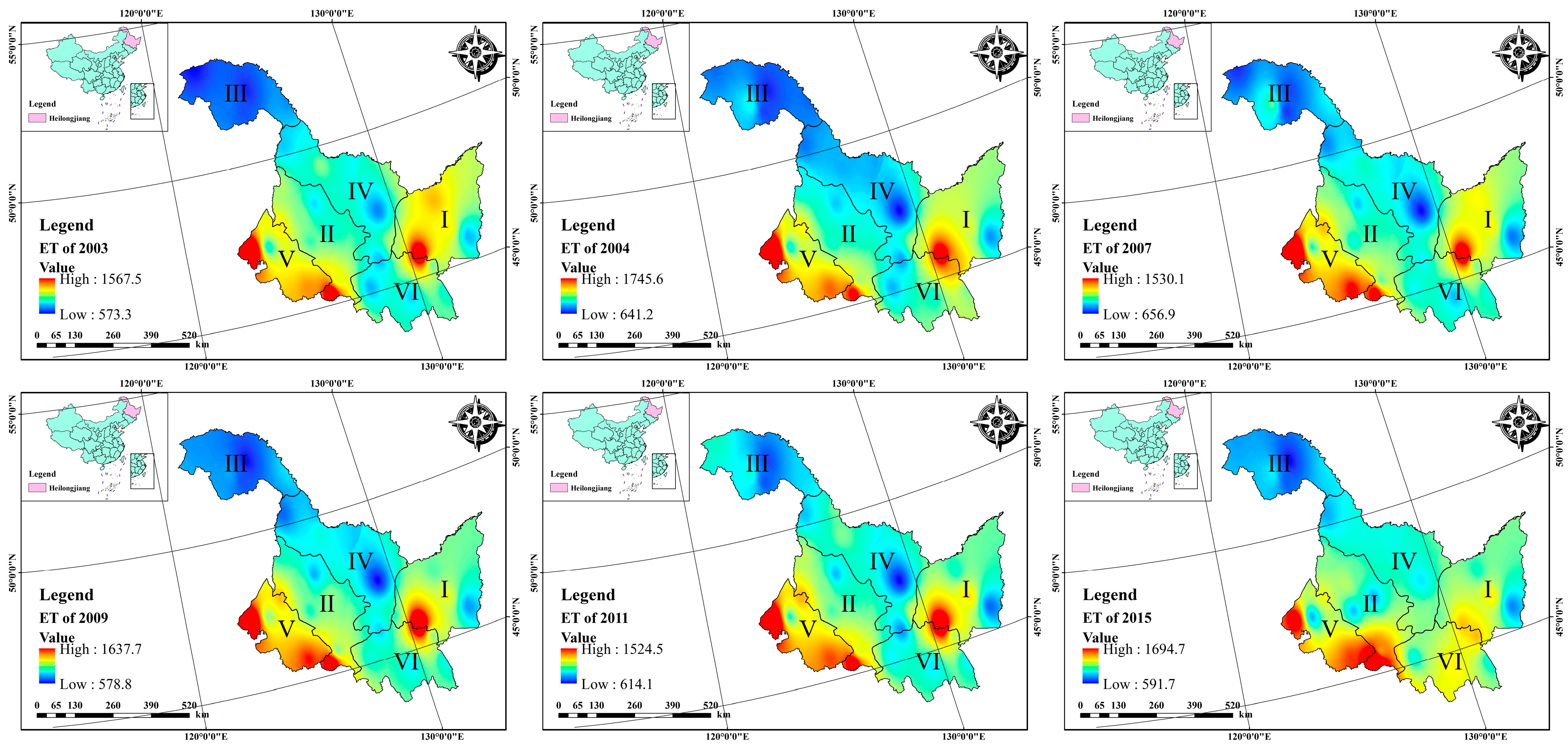


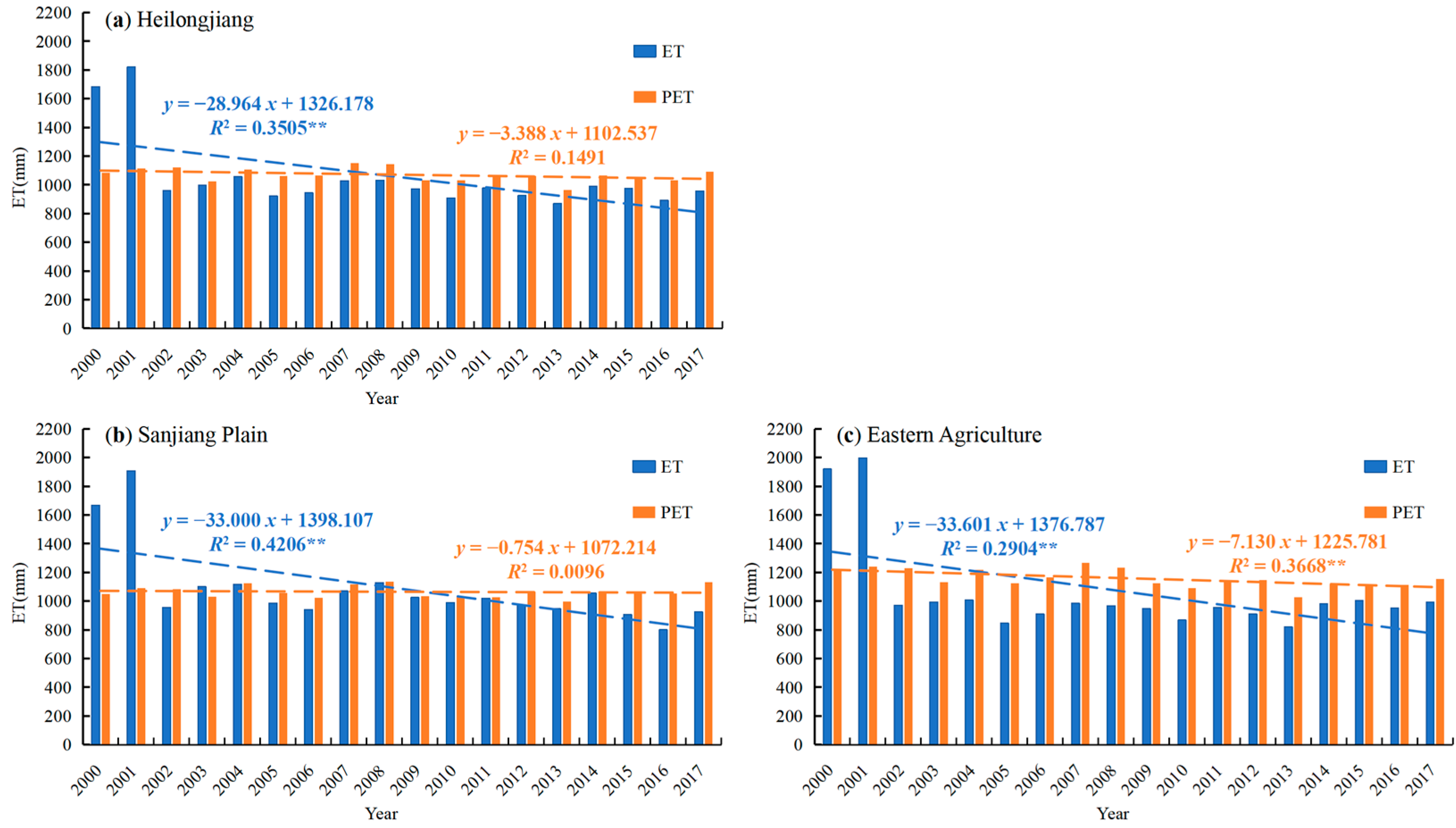
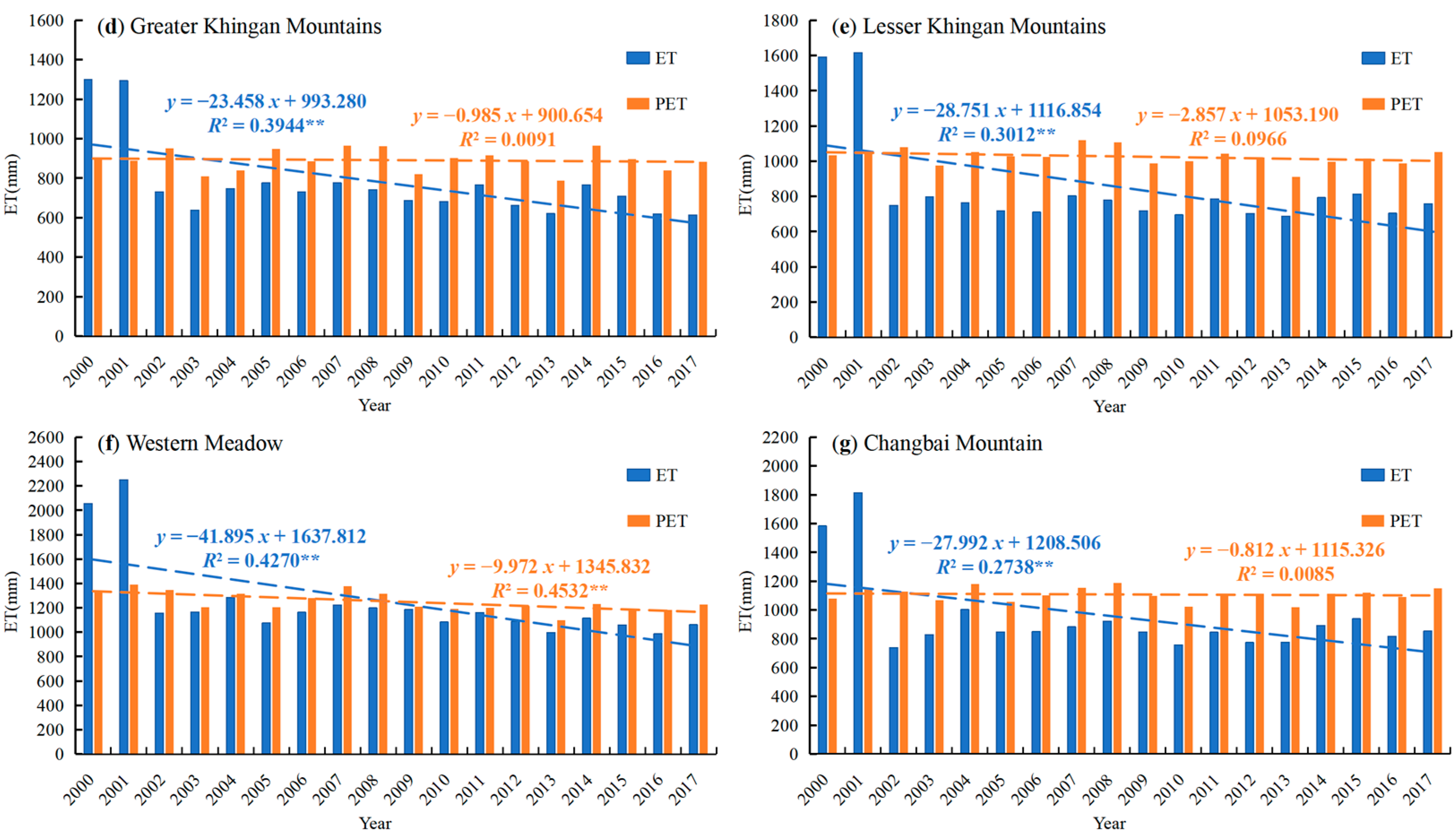
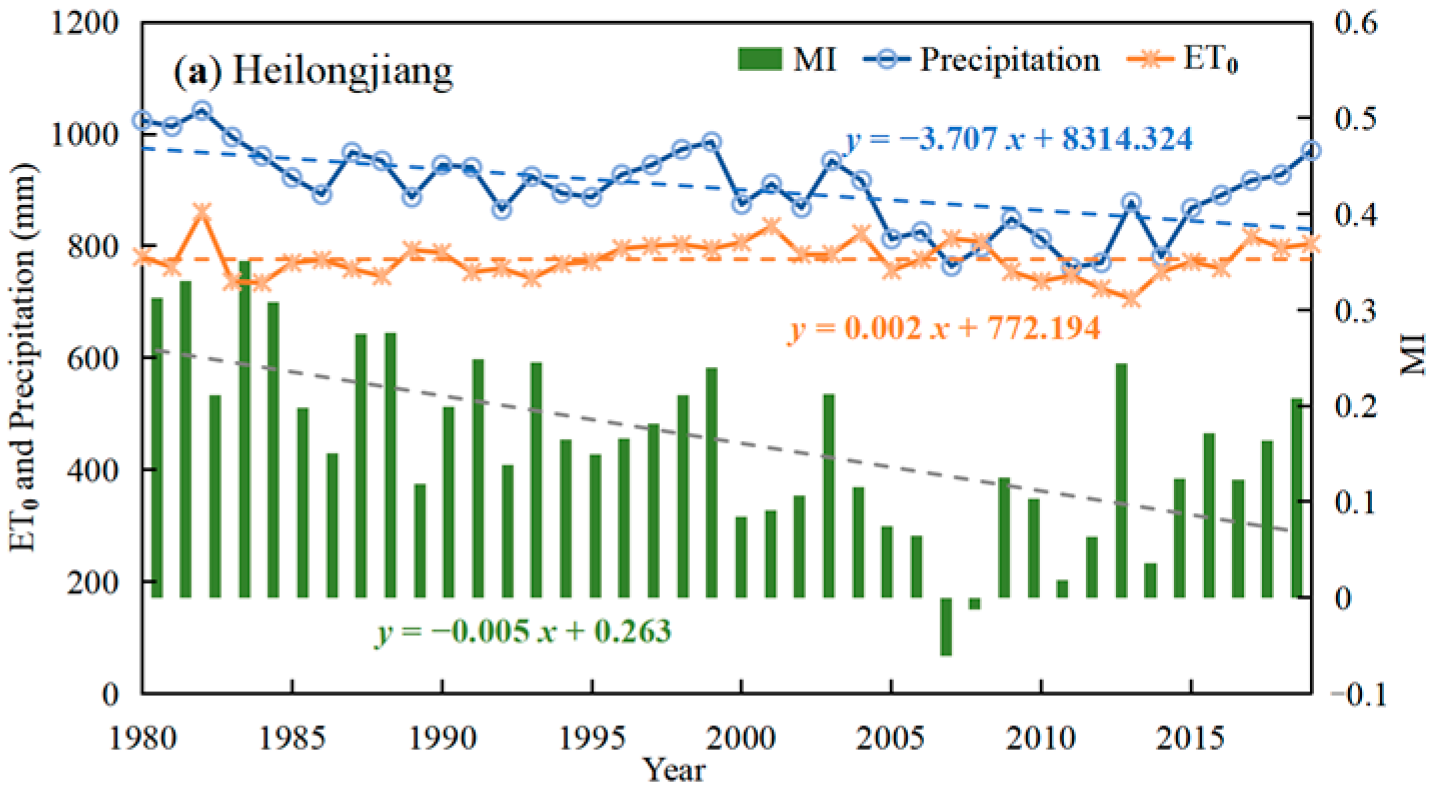


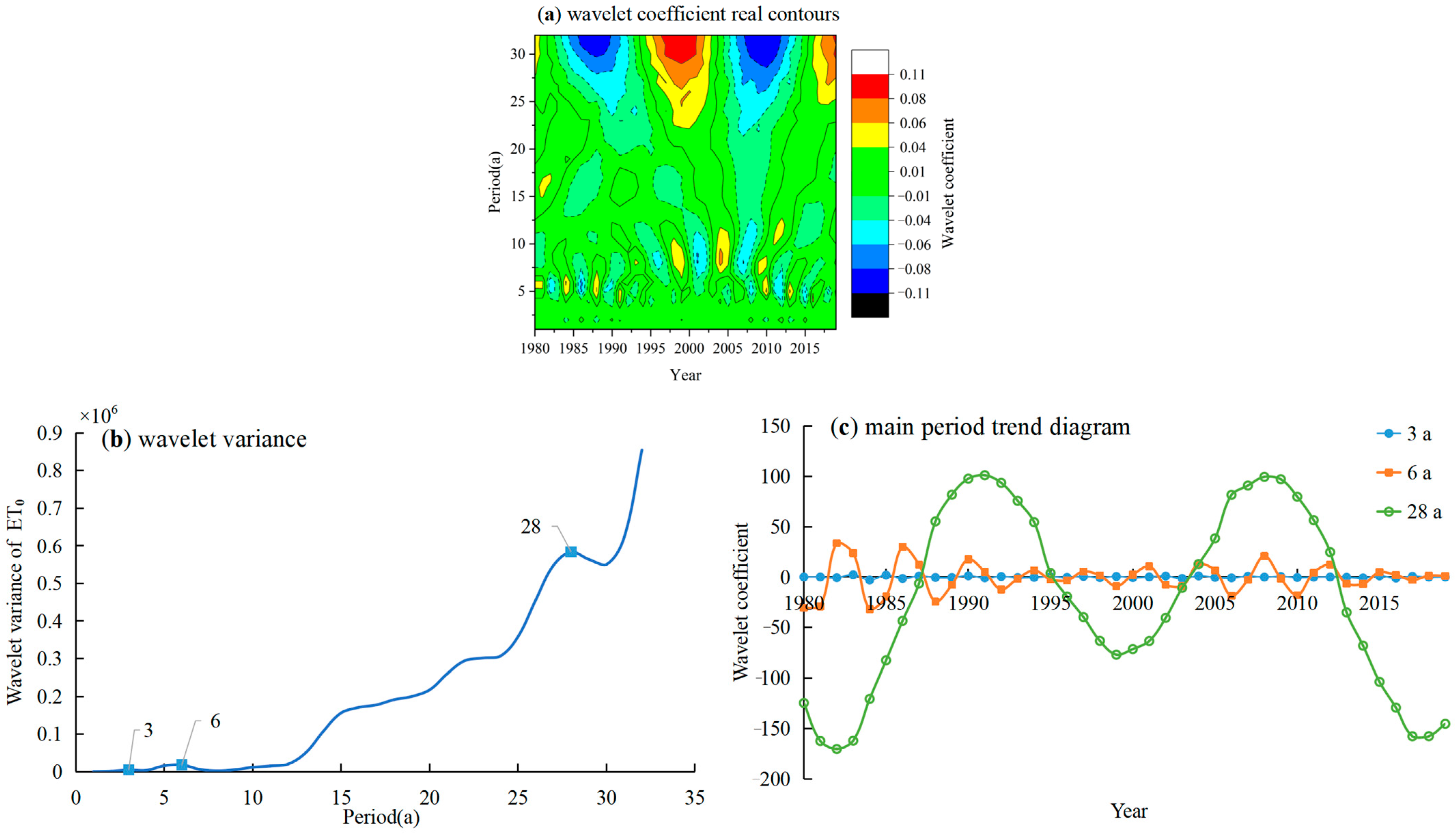
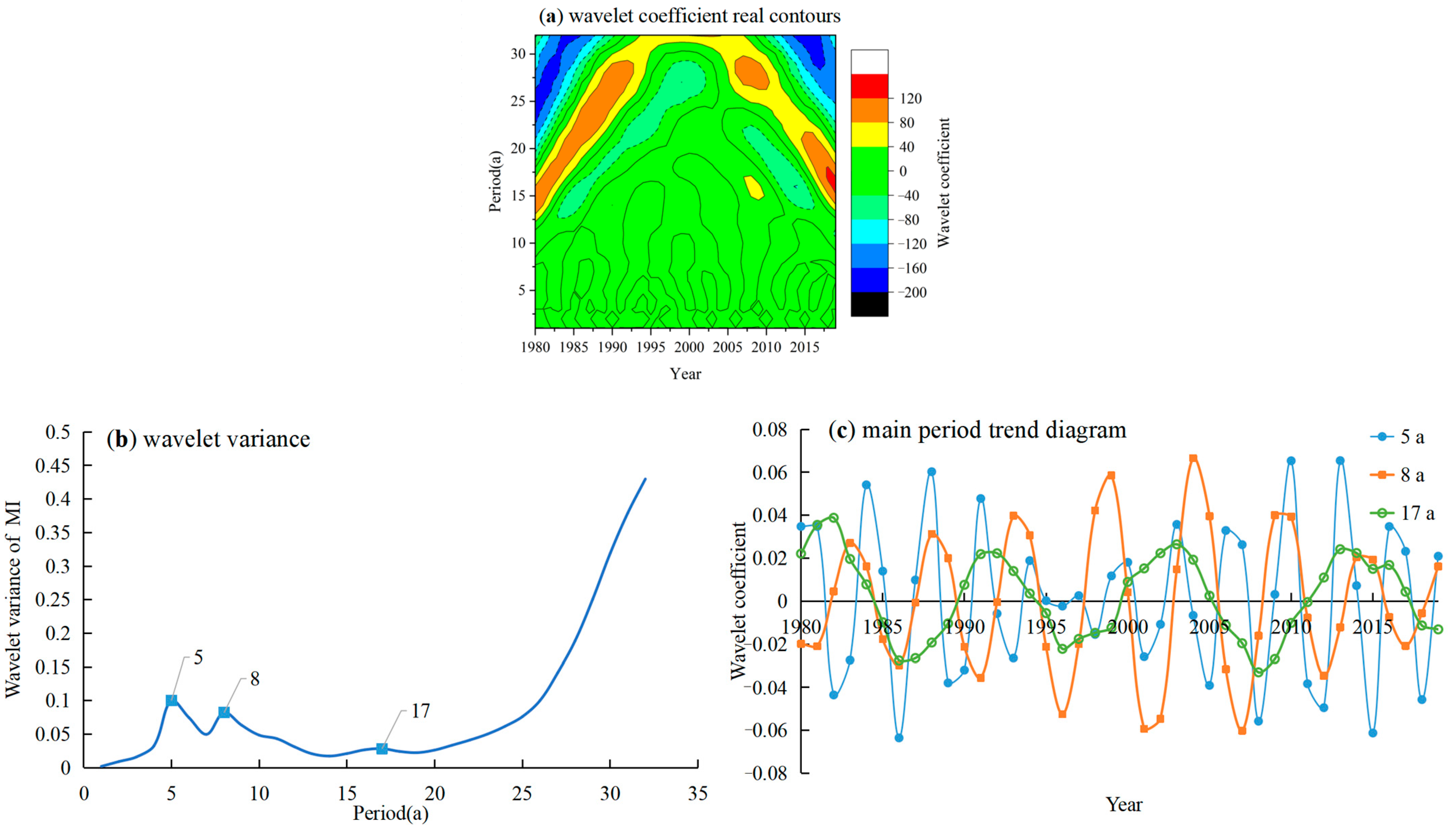

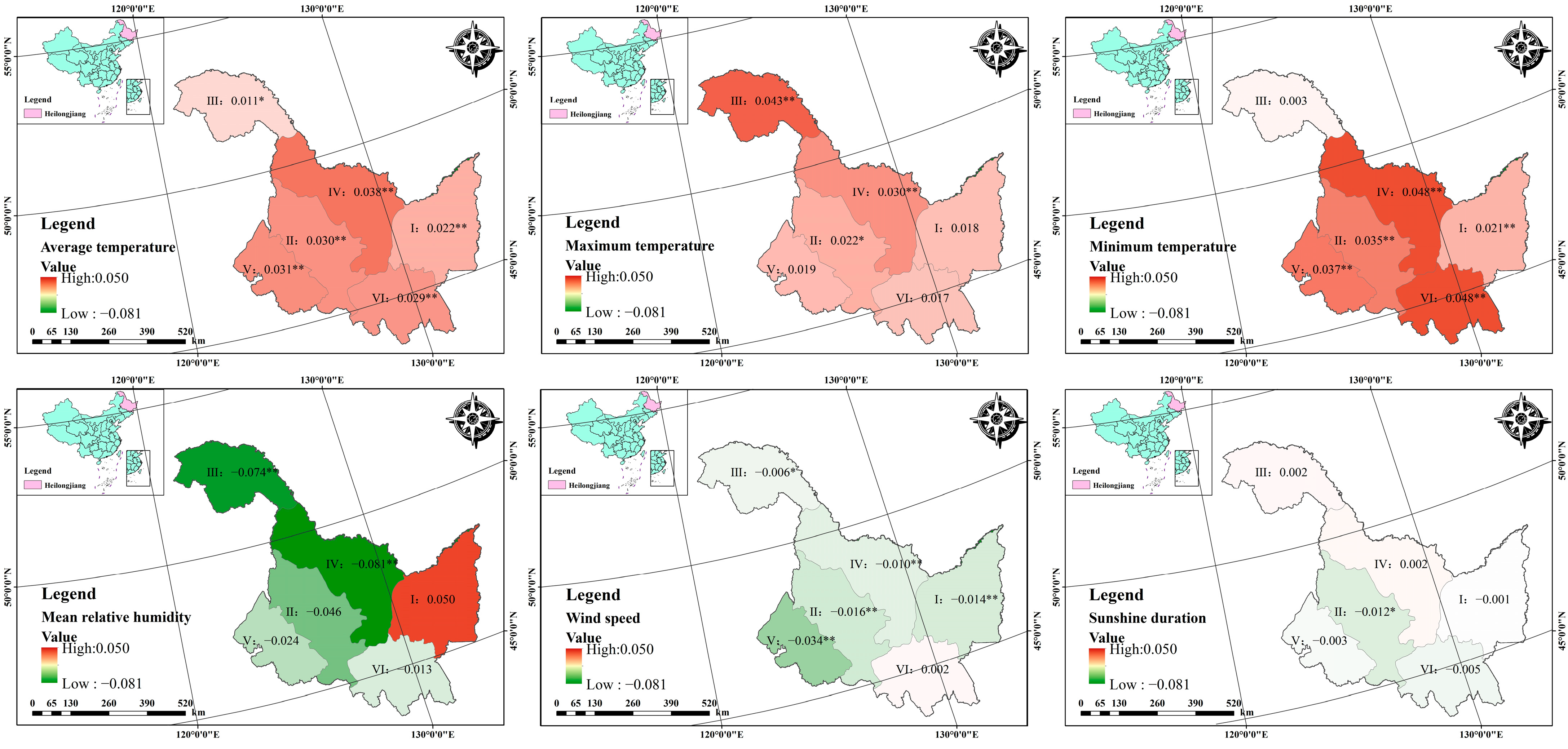
| Product Name | Satellite Orbit | Time Span | Spatial Resolution | Temporal Resolution | Data Source |
|---|---|---|---|---|---|
| MOD16 A3 | h25v03/h25v04 | January 2000–December 2017 | 500 × 500 m | 1 annum | USGS official website (https://lpdaac.usgs.gov/tools/appeears/, accessed on 16 January 2023) |
| h26v03/h26v04 | |||||
| h27v04 |
| Level | Type | Relative Moisture Index |
|---|---|---|
| 1 | No drought | −0.40 < MI |
| 2 | Light drought | −0.65 < MI ≤ −0.40 |
| 3 | Moderate drought | −0.80 < MI ≤ −0.65 |
Disclaimer/Publisher’s Note: The statements, opinions and data contained in all publications are solely those of the individual author(s) and contributor(s) and not of MDPI and/or the editor(s). MDPI and/or the editor(s) disclaim responsibility for any injury to people or property resulting from any ideas, methods, instructions or products referred to in the content. |
© 2023 by the authors. Licensee MDPI, Basel, Switzerland. This article is an open access article distributed under the terms and conditions of the Creative Commons Attribution (CC BY) license (https://creativecommons.org/licenses/by/4.0/).
Share and Cite
Wen, S.; Liu, Z.; Han, Y.; Chen, Y.; Xu, L.; Li, Q. Spatiotemporal Variation Characteristics of Reference Evapotranspiration and Relative Moisture Index in Heilongjiang Investigated through Remote Sensing Tools. Remote Sens. 2023, 15, 2582. https://doi.org/10.3390/rs15102582
Wen S, Liu Z, Han Y, Chen Y, Xu L, Li Q. Spatiotemporal Variation Characteristics of Reference Evapotranspiration and Relative Moisture Index in Heilongjiang Investigated through Remote Sensing Tools. Remote Sensing. 2023; 15(10):2582. https://doi.org/10.3390/rs15102582
Chicago/Turabian StyleWen, Siyi, Zihan Liu, Yu Han, Yuyan Chen, Liangsi Xu, and Qiongsa Li. 2023. "Spatiotemporal Variation Characteristics of Reference Evapotranspiration and Relative Moisture Index in Heilongjiang Investigated through Remote Sensing Tools" Remote Sensing 15, no. 10: 2582. https://doi.org/10.3390/rs15102582






